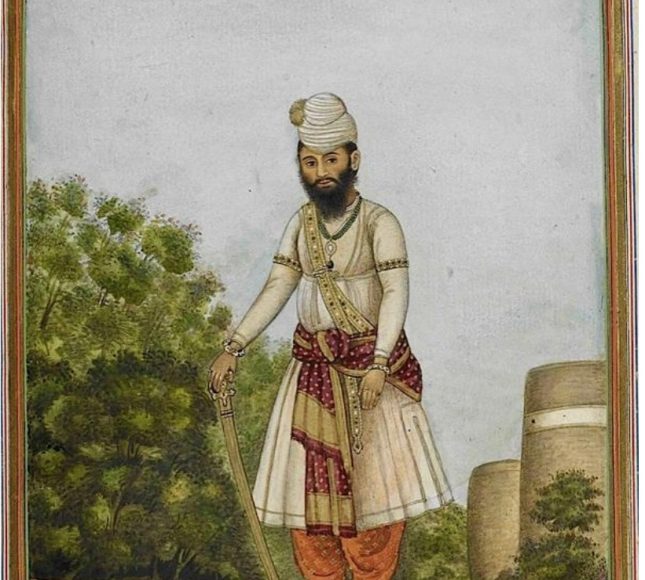BHAG SINGH CHANDRA UDAYA, an undated manuscript preserved in the Punjab State Archives, Patiala, under accession No. M/773, deals with the life and achievements of Sardar Bhag Singh Ahluvalia (1745-1801), who succeeded Sardar Jassa Singh Ahluvalia as ruler of Kapurthala state in 1783. Its author, Ram Sukh Rao, was tutor to Bhag Singh`s son and successor, Fateh Singh Ahluvalia (1784-1836). The latter, after his accession in 1801, commissioned Ram Sukh Rao to write biographies of Sardar Jassa Singh and Sardar Bhag Singh. Bhag Singh Chandra Udaya, a biography of the latter, comprises 188 folios, size 22 x 16 cm, each page containing 16 lines.
The first 107 folios cover events of the life of Jassa Singh, and the rest deal with the rule of Bhag Singh ending with his death in 1801. The language of the manuscript is a mixture of Hindi, Sanskrit, Punjabi and Persian, but the script is Gurmukhi. Ram Sukh Rao is also the author of a book devoted to the life of Jassa Singh. That also is an unpublished manuscript under the title Sri Jassa Singh Binod, preserved in the Punjab State Archives, Patiala. B.S.N.
Bhag Singh Chandra Udaya, a rare manuscript that illuminates the life and achievements of Sardar Bhag Singh Ahluvalia—the ruler of Kapurthala state between 1783 and 1801.
Historical Context and Patronage
The manuscript, preserved in the Punjab State Archives in Patiala (accession No. M/773), offers a unique window into the regional history of Kapurthala during a time when local rulers were asserting both autonomy and cultural identity. Sardar Bhag Singh Ahluvalia, born in 1745 and ruling until his death in 1801, succeeded Sardar Jassa Singh Ahluvalia. The biography was commissioned by Fateh Singh Ahluvalia, Bhag Singh’s son and successor (1784–1836), as part of an effort to document and legitimize the lineage and achievements of the Ahluvalia dynasty. Its author, Ram Sukh Rao—who also served as the tutor of Fateh Singh—was a meticulously trained chronicler. His work not only presents a historical record but also reinforces the political and cultural prestige of the ruling family during a period of rising local power amid broader regional dynamics .
Manuscript Features and Composition
Bhag Singh Chandra Udaya is a carefully crafted work comprising 188 folios, each measuring approximately 22 x 16 centimeters and arranged with a uniform structure of 16 lines per page. Notably, the manuscript is not confined to a single linguistic tradition. It employs a fascinating mix of Hindi, Sanskrit, Punjabi, and Persian while being written in the Gurmukhi script. This eclectic linguistic blend reflects the socio-cultural interchanges of the period and indicates that the work was intended not only as a formal biography but also as a literary document resonating with diverse audiences. Interestingly, the first 107 folios are devoted to recounting the life events of Sardar Jassa Singh Ahluvalia, while the remainder details the rule of Sardar Bhag Singh Ahluvalia, culminating in his death in 1801. This structural division emphasizes the continuity and transformation between the generations of Ahluvalia rulers .
Literary and Cultural Significance
The manuscript is a rare example of indigenous historiography produced during an era when local society was deeply engaged in the process of self-definition. By recording the deeds and governance of Bhag Singh Ahluvalia, the text not only contributes to our understanding of the political evolution in Kapurthala but also serves as a vehicle for preserving regional pride and cultural identity. Ram Sukh Rao’s expository style—rich with historical detail and nuanced analysis—illustrates the ways in which local histories were interwoven with broader cultural narratives. The use of multiple languages and scripts in a single document symbolizes the interconnected nature of Indian intellectual traditions and underscores the manuscript’s role as a bridge between oral history, literary artistry, and recorded discourse.
Moreover, the manuscript’s existence reinforces the importance of biographical works commissioned by ruling families. Such texts were central to legitimizing power through the construction of a revered past, enabling rulers to present themselves as natural heirs to cultural and military greatness in turbulent times. In this context, Bhag Singh Chandra Udaya is not merely a record of one man’s life—it is a carefully curated testimonial to a dynasty’s enduring legacy .



